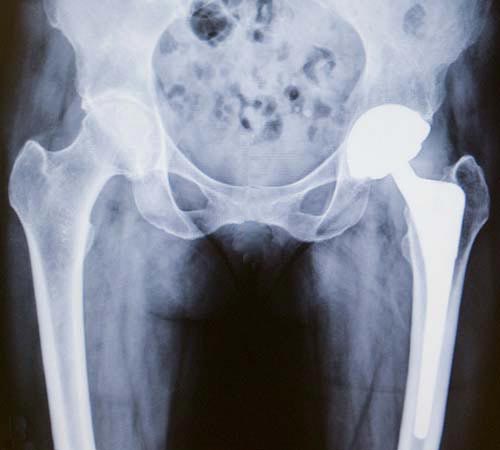| Category | TOTAL HIP REPLACEMENT |
Hip replacement is highly successful surgery in which portions of the damanged hip joint (acetabulum and femur head) are replaced with prostheses (implants).
Hip replacement is the removal and replacement of portions of the pelvis and femur (thighbone) that form your hip joint. It is performed primarily to relieve hip pain and stiffness caused by HIP ARTHRITIS.
This procedure is also sometimes used to treat injuries such as a broken or improperly growing hip, and for other conditions.
If you have these arthritis symptoms, you should consider a hip replacement:
The hip is a ball-and-socket joint. The ball, at the top of your femur (thighbone) is called the femoral head. The socket, called the acetabulum, is a part of your pelvis. The ball moves in the socket, allowing your leg to rotate and move forward, backward and sideways.
In a healthy hip, soft-tissue called cartilage covers the ball and the socket to help them glide together smoothly. If this cartilage gets worn down or damaged, the bones scrape together and become rough. This condition, osteoarthritis, causes pain and restricts motion. An arthritic hip can make it painful to walk or even to get in or out of a chair. If you have been diagnosed with hip arthritis, you may not need surgery. Nonsteroidal anti-inflammatory drugs (NSAIDs) and/or physical therapy may provide relief. But, if these efforts do not relieve symptoms, you should consult an orthopedic surgeon.
The three major types of hip replacement are:
The most common type of hip replacement surgery is called a total hip replacement (also called total hip arthroplasty). In this surgery, worn-out or damaged sections of your hip are replaced with artificial implants. The socket is replaced with a durable plastic cup, which may or may not also include a titanium metal shell. Your femoral head will be removed and replaced with a ball made from ceramic or a metal alloy. The new ball is attached to a metal stem that is inserted into the top of your femur. (Learn more about types of hip implants.)


X-ray of a total hip replacement showing the ball, socket and stem implants
Total hip replacement surgery takes about one and a half hours. Most patients also stay in the hospital for 2-3 days days after the procedure.
Your rehabilitation will begin within 24 hours after surgery. Most hip replacement patients progress to walking with a cane, walker or crutches within day or two after surgery. As the days progress, you will increase the distance and frequency of walking. you may need to continue physical therapy outside the hospital for 6 to 8 weeks. After that period, most patients are able to do everyday activities and return to playing sports.
Yes, healthy patients younger than 75 years old who have no history of cardiopulmonary disease may be able to have both hips replaced at once. In some cases, however, it may be better to stage the surgeries.
There are three separate implants: the stem, the ball and the socket.
Generally speaking, a hip replacement prosthesis should remain effective for between 10 and 20 years, and some can last even longer.
Results vary according to the type of implant and the age of the patient. In a 2008 study of more than 50,000 patients who had THR surgery at age 55 or older, between 71% and 94% still had well-working implants after 15 years.
When a hip implant does need to be replaced because it has loosened or worn out over time, this requires what is called hip revision surgery.
Most patients can resume driving by six weeks after surgery.